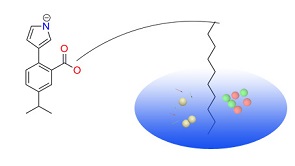Before submit your job -
Before submitting your job, please fill some brief register information to help us do some statistic study. Please do provide a valid e-mail address so as to receive the mail reminder about the job status.
Submit Job -
Please provide a file with single drug-like molecule or natural product stored in MOL2 or SDF format. If the uploaded molecule does not have 3D structural information, the server will automatically convert it into a single 3D conformer. After uploading the file, press the "Submit" button to set the parameters of PharmMapper.
- Basic Options:
- (1) Generate Conformers - PharmMapper adopts semi-rigid pharmacophore mapping protocol. As a result, multiple conformations of the query molecule are required prior to mapping. The user can generate a conformer ensemble either online (use our MOEA-based conformation generation algorithm Cyndi incorporated in PharmMapper) or offline (generate with other external conformation generation programs and store the resulted conformers as one submitted Mol2 file). Cyndi is used as default option (Generate Conformers set as "TRUE") and the computational cost is proportional to the number of conformers.
- (2) Maximum Generated Conformations - Maximum conformations to be generated in Cyndi.
- (3) Number of Objectives used in MOEA - Number of objectives used in multi-objective evolution algorithm in Cyndi.
- (4) Select Targets Set
- Version 2010. Currently there are 7,302 pharmacophore models in PharmTargetDB and 2,241 of them are annotated as the potential protein targets in Human. Due to the limit size of human protein pdb subsets, more pharmacophore models from other origins (like other mammals, prokaryotes and eucaryotes) with sequential homologys to corresponding human proteins are also enclosed. All the 7,473 models are included in the target identification by default, but the users are encouraged to switch to "Human Targets Only" if they want to focus on current available human protein targets.
- Version 2017. PharmMapper applies Cavity to detect the potential binding sites on the surface of a given protein structure and rank them according to the corresponding druggability scores. A receptor-based pharmacophore modeling program Pocket was then used to extract pharmacophore features within cavities. In this approach, a total of 23236 proteins covering 16159 pharmacophore models which are predicted as druggable binding sites and 52431 pharmacophore models with a pKd value higher than 6.0 are picked out, which is currently the largest collection of this kind.
- (5) Perform GA Match - PharmMapper can use genetic algorithm to optimize the pharmacophore mapped poses (maybe 5-6 times slower than no GA optimization)
- (6) Number of Reserved Matched Targets - Maximum number of top ranked potential target candidates to be reserved in the "Get Result" page.
- Advanced Options:
- (1) Fit Value Cutoff - A threshold for discarding the matching results in which the fit value of the aligned pose on the target pharmacophoe is below this threshold. Must be greater than zero.
- (2) Vector Angle Cutoff - A threshold for discarding the matching results in which the vector angles between the vector features from the molecules and the target pharmacophoe are larger than this threshold. The value must be between 0 degree and 180 degree.
- (3) Weight of Hydrophobic Score (Hydrogen Bond Donor, Hydrogen Bond Acceptor, Positive Charged Center, Negative Charged Center, Aromatic Ring) - Individual weights of each feature types for fit value calculation.
- (4) Minimum Number of Hydrophobic Center (Hydrogen Bond Donor, Hydrogen Bond Acceptor, Positive Charged Center, Negative Charged Center, Aromatic Ring) - If a pharmacophore model possesses less features (hydrophobic, HB donor, HB acceptor, positive charged, negative charged or aromatic ring) than user required minimum numbers, it will be skipped without mapping.
Check Job -
After submitting your job successfully, a unique job id was returned. Please do remember this id because it's the only way to access your job status and PharmMapper results. You can check your job status by inputting the job id in Check Job page.
Get Result -
A typical run of PharmMapper task for the old version database takes 1~2 h, while it costs 4~6 h for the druggable target pharmacophore database and 20~24 h for the ligandable target pharmacophore database. The results for the jobs will be remained on the server for no shorter than 45 days.
You can get your PharmMapper result by input the job id in Get Result page. PhamMapper outputs top N (N was user-defined) potential target candidates and corresponding annotations ranked by PharmMapper's FitScore in a summary table. By clicking the "+" icon at the beginning of each row, more details about the pharmacophore model and visualization of ligand-pharmacohore superposition are presented in the drop-down sub-windows. The annotations of each targets can be shown in the pop-up sub-windows when your cursor hovering over the corresponding PDB ID link. More detailed annotations can be accessed from PDB and TargetDB via the crosslinks. We also provide best mapped poses (in Mol2 format) of the query molecules against the candidates' pharmacophore respectively for downloading.
Since a protein may have many PDB structures presenting identical or distinct pharmacophores in the binding site, we have regrouped those PDB structures and adjusted to list only the PDB file with the highest score.
Fit score and z'-score
- z'score is a score generated from the molecule's fit score and a library score matrix calculated beforehand . It combines the fit score and its corresponding vector in the score matrix together and normalizes it to a vector with a mean of zero and a standard deviation of one. Compared to the fit score z'-score not only applys the pharmacophore matching method but also consider some statistic factor lying behind, say, normal distribution a randomly given molecule's fit score may follow. Generally, large positive z'-score should indicates high significance of the target to a query compound, as well, large negative z'-score indicates the target may not be significant enough. By doing this, we hope the z'-score will adds up to the pure fit score with more statistical meaning and confidence comparing.



